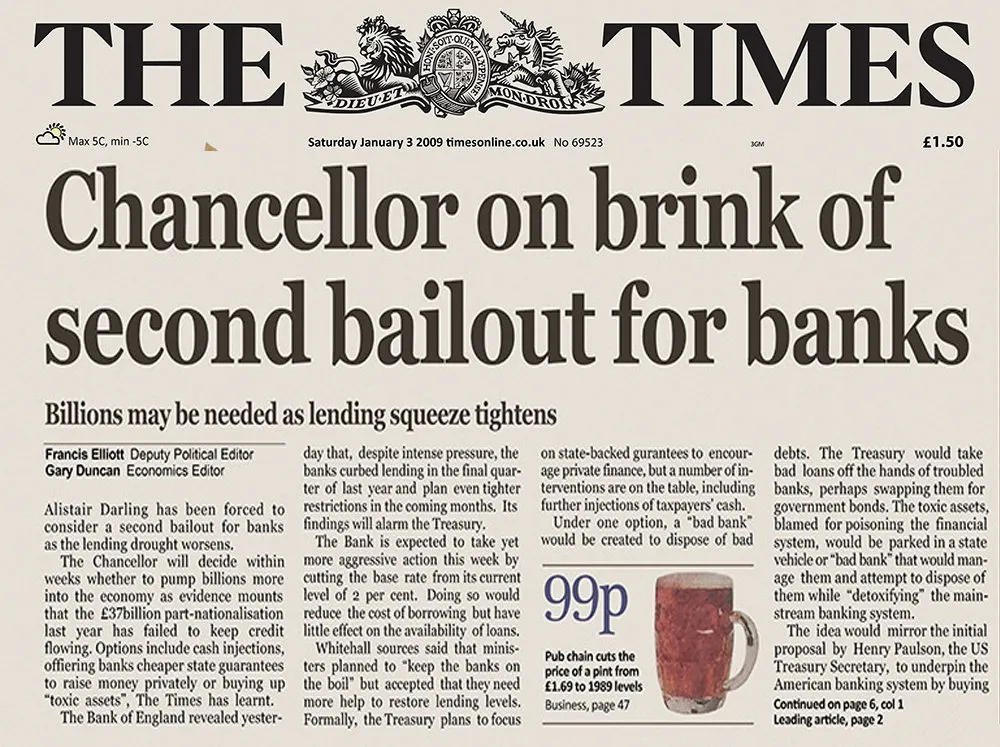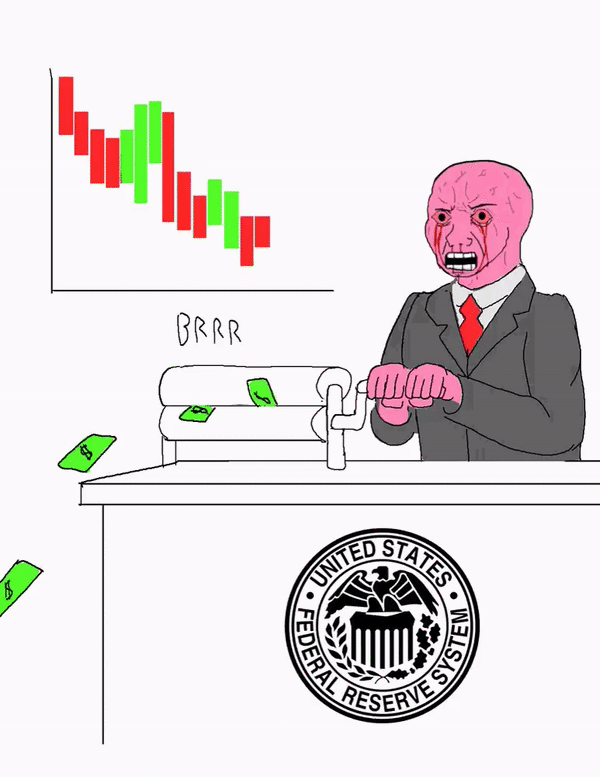When Satoshi Nakamoto minted the first Bitcoin block he included a follow text in this genesis block:
"The Times 03/Jan/2009 Chancellor on brink of second bailout for banks".
It references this headline:

If Satoshi were around today perhaps he would mint a block referencing a headline like this:
"With companies on borrowing spree, Federal Reserve expands lending backstops"
or this:
Fed’s ‘Infinite Cash’ Put to the Test in a World of Leverage
Essentially, the Fed is saying that it will print an unlimited amount of money to bail out not just the banks but all the major corporations (by buying their debt and perhaps even their stocks like in Japan) and even to provide some helicopter money to regular people.
We have all seen the money printer goes Brrr meme and most instinctively know there is something wrong with this.

There is even an economic theory to try to justify it.
It is called Modern Monetary Theory (MMT) but I prefer to call it "Monetary Magic Tricks".
It says that monetarily sovereign countries like the U.S., U.K., Japan and Canada are not operationally constrained by revenues when it comes to federal government spending. In other words, such governments do not need taxes or borrowing for spending since they can print as much as they need and are the monopoly issuers of the currency.
According to MMT, the only limit the government has when it comes to spending is the availability of real resources, like workers, construction supplies etc. When government spending is too great with respect to the resources available, inflation can surge if decision makers are not careful. Source: Investopedia
What is the problem with the government just printing massive amounts of new money and giving it out to everyone?
The traditional answer is that printing too much money leads to hyper-inflation, but we haven't seen this (yet) because of the US Dollar's role as the world's reserve currency. Indeed there is currently a huge shortage of US Dollars (and the greenback is rising) because of the massive amount of US$ denominated debt all around the world.
To answer the above question properly we have to take a closer look at the foundations of MMT to reveal two very serious flaws relevant to today's situation.
- MMT assumes that governments are "monetarily sovereign" which means they have a complete monopoly on the money their citizens use.
- MMT assumes that both supply and demand for goods and services are expanding to support the extra money created.
People, not governments are sovereign
Governments are not monetarily sovereign.
The people are sovereign and they make choices regarding which money to use and give value to.
This has been true for all human history and when people lose faith in a government's money, that government collapses. From the fall of the Roman Empire to many failed historical experiments with fiat currencies this reality has held true.
Even within the current fiat currency system, all governments in the world rely on the US Dollar as the global reserve currency and huge amounts of local debt is denominated in US$. So non-US governments are clearly not monetarily sovereign. If they print too much money their exchange rate collapses versus the US Dollar with very problematic consequences for them (including huge difficulty servicing US$ debt).
When I first visited Israel in the 1990s, apartment rents and sale prices were still denominated in US Dollars because of a hyper inflationary episode in the 1980s.
But even the US itself doesn't have full monetary sovereignty precisely because of all these US dollars and US$ debt swirling around the rest of the world. If the US takes monetary action in one direction to support its domestic economy this can have the opposite effect globally which then reflects back into the US domestic economy via trade.
Bitcoin, Gold, Silver and other cryptocurrencies
Even more importantly, there are alternatives to national fiat currencies which people are increasingly adopting:
Both very old ones: Gold and Silver; and very new ones: Bitcoin and other cryptocurrencies.
The existence of viable alternatives, even with low adoption rates, completely destroys the notion of monetary sovereignty. The government does not have a monopoly and people can and will chose to use other forms of money if they lose confidence in their national fiat currency.
If there were no alternatives, no external measuring stick, maybe governments could get away with MMT justified endless money printing. But this has never been the case.
There have always been external measuring sticks, indeed money in the form of gold and silver existed long before national governments. National currencies developed as a sovereign stamping a piece of gold or silver to certify its weight as a convenience.
Today, external measuring sticks like Bitcoin provide conveniences such as global acceptability, instant low cost transfers, automatic accounting and elimination of counter-party risk that national fiat currencies lack.
Because Gold, Silver, Bitcoin and serious cryptocurrencies are inherently scarce, with a fixed, low inflation, issuance schedule and no ability to create more than allowed by this schedule, they provide the certainty as to future value that is essential for capitalism to function properly.
A business investing in something (plant, equipment, staff, technology) to create a future return over a long period must have confidence that the money received in the future will have a stable relationship to that invested today. Interest rates are supposed to reflect this relationship but have become unmoored due to central bank manipulation.
Supply and Demand are shrinking and will continue to do so
The Coronavirus Crisis has created huge supply shocks, demand shocks, credit shocks and unemployment shocks that will continue to reverberate through the world economy for some time. Like multiple tsunamis racing across the oceans these waves will intersect at various points cracking the very foundations of current financial systems.
We may experience both hyperinflation and deflation consecutively or even at the same time in different places.
For a time chaos will reign.
When these shock subside, the wreckage is surveyed and it is time to rebuild, two things will be clear:
- real demand for almost everything will be far less than it was before the crisis (we are already seeing this in energy markets);
- many complex global supply chains will be irrevocably broken and there will be neither the financial incentive nor the political appetite to rebuild them in a world of far more closed borders.
There will be a steep, permanent drop in both demand and supply which, when matched with immense MMT inspired money printing during the crisis, will lead to a permanent loss of value and faith in fiat currencies.
Moreover, because the working age and consumer populations of the first and second world are shrinking due to ultra low fertility, there will be no basis for demand and supply to grow into the future. The world will be stuck with declining supply and demand until 20 years after fertility increases substantially. More on this in my previous prophetic post from 31 January this year.
Collapse of fiat currencies and financial system
Within the next year or two the situation will be as follows:
With the two fundamental pillars of MMT inspired money printing revealed as dangerous fallacy, confidence in the central banks and governments that adopted it will be shattered.
The balance sheets of the world's central banks will be destroyed as all the assets they bought to prop up the markets and the economy will be revealed as worthless.
The world will be awash with immense amounts of US Dollars and other fiat currencies with the velocity of that money (use in real transactions) much slower than before and shrinking all the time.
People will have experienced helicopter fiat money - being given large amounts of money without having to work for it - and will begin to see fiat money as humans do all things obtained without effort - worthless.
The people of the world will be faced with a choice, continue to use these discredited and ever declining government issued fiat currencies or adopt alternatives.
Gold and Silver will be immensely valuable but practically difficult to use in a global, online, socially distanced world.
Bitcoin, Hive and other cryptocurrencies will be perfectly placed for mass adoption.
Bitcoin's ever decreasing inflation (next halving soon) will be well matched to a world of decreasing supply and demand.
Cryptocurrency's conveniences and low costs will make fiat currency payment systems look like stone age extortion (no more 3-5% Paypal or credit card fees for merchants).
The volatility which characterised cryptocurrencies' early years will disappear with wide scale adoption as real use outstrips speculation.
All other options will be either discredited or impractical.
The collective decision to abandon fiat currencies will likely happen with great rapidity and without warning - for those not reading articles like these :-)
For consumers and merchants changing over to cryptocurrency will be as simple as downloading a user friendly App (actually a decentralised App: a DApp) from one of many competing providers.
The complexities and throughput limitations that were a barrier to mass adoption in 2017 have been or soon will be substantially resolved.
Governments may initially try to force people to use their national fiat currencies but the will of the people will prevail in most places.
Some governments, like Russia, which have hoarded gold, may try to rebuild their national currencies based on a gold standard and use authoritarian powers to enforce its use. They will have some limited success.
Others will try to rebuild national currencies based on Bitcoin or a combination of it and Gold. This may also have some limited success, but why use such a currency when you can use Bitcoin itself?
In the end Bitcoin will become both the world's reference currency and its reserve currency with other cryptocurrencies fulfilling various roles in everyday transactions, micropayments and use in decentralised applications and digital assets. Hive will be well placed in these roles.
The extremely complex and fragile fiat based financial systems we have today will evaporate in a flash as the currency that underlay everything becomes worthless overnight. Non physical financial assets will become worthless.
Real estate will be revalued in Bitcoin based on real supply (scarcity) demand (fertility and economic growth/decline) and income generating capacity. Expensive playthings of the ultra rich like super yachts and private jets will be on firesale to those willing to part with a Bitcoin or two to pay for them.
I don't know the exact timing of all these things or exactly how they will play out and there will likely be many developments that I haven't predicted.
But the main questions most people will be asking are:
- Why did I believe in magic tricks of creating money out of nothing?
- Why didn't I buy (more) cryptocurrency sooner?